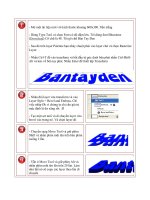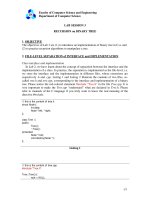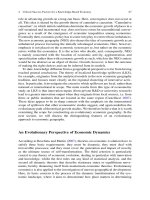califonia science interactive text 3
Bạn đang xem bản rút gọn của tài liệu. Xem và tải ngay bản đầy đủ của tài liệu tại đây (26.98 MB, 200 trang )
A
Published by Macmillan/McGraw-Hill, of McGraw-Hill Education, a division of The McGraw-Hill
Companies, Inc., Two Penn Plaza, New York, New York 10121.
Copyright © by Macmillan/McGraw-Hill. All rights reserved. No part of this publication may be
reproduced or distributed in any form or by any means, or stored in a database or retrieval system,
without the prior written consent of The McGraw-Hill Companies, Inc., including, but not limited to,
network storage or transmission, or broadcast for distance learning.
Printed in the United States of America
ISBN-13: 978-0-02-286007-3
ISBN-10: 0-02-286007-X
1 2 3 4 5 6 7 8 9 (079) 10 09 08 07 06
CHAPTER 1
Adaptations in Land Environments . . . . . . . . . . . . . 1
Lesson 1 Living Things and Their Needs . . . . . . . . . . . . . . 2
Lesson 2 Life in the Desert . . . . . . . . . . . . . . . . . . . . . . . . 10
Lesson 3 Life in the Grassland . . . . . . . . . . . . . . . . . . . . . 16
Lesson 4 Life in the Forest . . . . . . . . . . . . . . . . . . . . . . . . 22
Lesson 5 Life in the Arctic Tundra . . . . . . . . . . . . . . . . . . 30
Vocabulary Review . . . . . . . . . . . . . . . . . . . . . . . . . . . . . . . . 38
CHAPTER 2
Adaptations in Water Environments . . . . . . . . . . 39
Lesson 1 The Water Planet . . . . . . . . . . . . . . . . . . . . . . . 40
Lesson 2 Life in an Ocean . . . . . . . . . . . . . . . . . . . . . . . . 46
Lesson 3 Life in the Wetlands . . . . . . . . . . . . . . . . . . . . . 54
Vocabulary Review . . . . . . . . . . . . . . . . . . . . . . . . . . . . . . . . 60
CHAPTER 3
Environments Change . . . . . . . . . . . . . . . . . . . . . . . . . 61
Lesson 1 Living Things Change Their Environment . . . . 62
Lesson 2 Changes Affect Living Things . . . . . . . . . . . . . . 68
Lesson 3 Living Things of the Past . . . . . . . . . . . . . . . . . 76
Vocabulary Review . . . . . . . . . . . . . . . . . . . . . . . . . . . . . . . . 84
CHAPTER 4
Our Earth, Sun, and Moon . . . . . . . . . . . . . . . . . . . . 85
Lesson 1 Day and Night . . . . . . . . . . . . . . . . . . . . . . . . . . 86
Lesson 2 The Seasons . . . . . . . . . . . . . . . . . . . . . . . . . . . . 92
Lesson 3 The Moon . . . . . . . . . . . . . . . . . . . . . . . . . . . . . 98
Vocabulary Review . . . . . . . . . . . . . . . . . . . . . . . . . . . . . . . 104
iii
CHAPTER 5
Our Solar System . . . . . . . . . . . . . . . . . . . . . . . . . . . . . 105
Lesson 1 The Sun and Its Planets . . . . . . . . . . . . . . . . . 106
Lesson 2 Telescopes: Discovering the Solar System . . . . 112
Lesson 3 The Stars . . . . . . . . . . . . . . . . . . . . . . . . . . . . . . 116
Vocabulary Review . . . . . . . . . . . . . . . . . . . . . . . . . . . . . . . .122
CHAPTER 6
Matter . . . . . . . . . . . . . . . . . . . . . . . . . . . . . . . . . . . . . . . 124
Lesson 1 Solids, Liquids, and Gases . . . . . . . . . . . . . . . . .126
Lesson 2 Building Blocks of Matter . . . . . . . . . . . . . . . . .134
Lesson 3 Changing Matter . . . . . . . . . . . . . . . . . . . . . . 140
Vocabulary Review . . . . . . . . . . . . . . . . . . . . . . . . . . . . . . . 146
CHAPTER 7
Energy . . . . . . . . . . . . . . . . . . . . . . . . . . . . . . . . . . . . . . . 147
Lesson 1 Energy All Around . . . . . . . . . . . . . . . . . . . . . . 148
Lesson 2 Using Energy . . . . . . . . . . . . . . . . . . . . . . . . . . 156
Lesson 3 Energy on the Move . . . . . . . . . . . . . . . . . . . . 162
Vocabulary Review . . . . . . . . . . . . . . . . . . . . . . . . . . . . . . . .170
CHAPTER 8
Light . . . . . . . . . . . . . . . . . . . . . . . . . . . . . . . . . . . . . . . . . .171
Lesson 1 How Light Moves . . . . . . . . . . . . . . . . . . . . . . .172
Lesson 2 Seeing Light and Color . . . . . . . . . . . . . . . . . . .178
Lesson 3 Shadows . . . . . . . . . . . . . . . . . . . . . . . . . . . . . 184
Vocabulary Review . . . . . . . . . . . . . . . . . . . . . . . . . . . . . . . 190
iv
CHAPTER 1
environment all the
living and nonliving
things in a place
biome a place with
certain kinds of living
and nonliving things
adaptation a body
part or way of acting
that helps a living
thing survive
desert a place with
hot, dry weather
migrate to move
from one place to
another
grassland a place
with many grasses
forest a place with
many trees
mimicry when one
thing pretends to be
another thing
arctic tundra a
cold place above the
Arctic Circle
Vocabulary
Adaptations in Land
Environments
What are adaptations, and how do
they help living things survive?
1
Chapter 1
Lesson 1
Living Things and Their Needs
Where do living things live?
Living things live where they can meet
their needs. A living thing’s environment
includes all the living and nonliving things
in a place.
A biome is a place that has certain kinds
of living and nonliving things. Deserts,
forests, and grasslands are types of biomes.
A buffalo eats the grass
in its biome.
2
Adaptations in Land Environments
Different biomes have different kinds of
weather over time. Some biomes are cold
and dry. Some are warm and wet. The soil,
or ground covering, might also be different.
It might be hard or soft, moist or dry.
Quick Check
1. How might one biome be different from another?
2. Describe the kinds of weather in your biome.
A desert biome has a
hot, dry climate.
3
Chapter 1 • Lesson 1
Roots get water
and food.
Stems carry water
and food.
Parts of a Plant
How do plants get what
they need?
Most plants need the same things to live.
They need water, light, food, and carbon
dioxide. Carbon dioxide is found in the
air. They must get all these things in their
environment.
4
Adaptations in Land Environments
This diagram shows the parts of
a plant that help it live.
Read a Diagram
Leaves get sunlight
and carbon dioxide.
Most plants have roots, stems, and leaves.
Each part of a plant helps it to live. Roots
get water and food from the ground. Stems
carry food and water through the plant.
Leaves get sunlight and carbon dioxide.
Other parts, like flowers and seeds, help
a plant make more plants.
Quick Check
3. Which plant part takes things from the ground?
4. Why might some plants need long roots?
5
Chapter 1 • Lesson 1
How do animals get what
they need?
Animals also need certain things to live.
They need water, food for energy, and
oxygen from the air or water. They also
need a place to stay safe.
An animal’s parts help it to live in its
environment. Legs or wings help it move.
Teeth or beaks help it eat.
A A lion uses its tongue to get water.
6
Adaptations in Land Environments
Quick Check
5. What body parts help you eat?
6. Circle the body part that helps a dog get oxygen.
wing tail lungs gill
When animals breathe, they take in
oxygen. Many animals have lungs to
get oxygen from the air. Fish use gills to
get oxygen from water.
Other animal parts help keep them
safe. They might also use their parts to
help build homes and shelters. Birds use
their beaks to build nests for shelter.
gills
A Birds use nests
for shelter.
7
Chapter 1 • Lesson 1
What helps living things survive in
their environment?
Living things live where they can meet
their needs. A redwood tree needs a cool, wet
environment with rich soil. A cactus needs a
warm, dry environment with sandy soil.
Quick Check
Circle the proper conditions for each plant in the chart below.
Plant Temperature Type of Soil
Amount
of Moisture
7. Cactus warm cool rich sandy dry damp
8. Redwood warm cool rich sandy dry damp
Cactus Redwood
8
Adaptations in Land Environments
-Review Summaries and quizzes online @ www.macmillanmh.com
Quick Check
9. Look at the photo. What adaptations might
help this bear catch fi sh?
Living things have adaptations to
help them survive in an environment. An
adaptation is a body part or a way of
acting that helps a living thing survive.
Plants might have long roots to reach water
deep in the ground. Animals might have a
certain way of finding food to eat.
A bear catches fish
in a river for food.
9
Chapter 1 • Lesson 1
Lesson 2
Life in the Desert
What is a desert?
A desert is a biome with warm,
dry weather. The Sonoran Desert
is the largest desert in North
America. A desert gets less than
25 centimeters (10 inches) of rain
each year. There may be one day
with a lot of rain. Then months
may pass with no rain at all.
desert biomes
A This map shows the
locations of the deserts
of the world.
The Sonoran Desert
10
Adaptations in Land Environments
A desert can get very hot during the day.
The Sun’s heat warms the land and air. At
night, the desert can cool off quickly.
Desert soil is mostly sand. Rain quickly
drips through the sand. The water goes
deeper than most plants’ roots can reach.
Quick Check
Tell whether each statement is true or false.
10. A desert gets more than 25 centimeters
of rain each year.
11. Plants in a desert biome have adaptations that
help them live with only a little water.
11
Chapter 1 • Lesson 2
What adaptations help
desert plants?
Desert plants have adaptations that help
them get the water they need. Some plants
have deep roots. These reach down into the
ground for water. Other plants have shallow
roots. These trap the water when rain falls.
mesquite tree
saguaro cactus
Adaptations of Desert Plants
These diagrams show adaptations
in two different desert plants.
Read a Diagram
Small leaves help
save water.
Sharp thorns keep
animals away.
Long roots reach
deep underground.
Sharp spines keep
animals away.
Thick, waxy stem
helps store water.
Shallow roots trap
water from rain.
12
Adaptations in Land Environments
Desert plants have other
adaptations that help them survive.
Thick stems help them save water.
Waxy skin helps seal in the water.
Thorns and spines keep animals from
eating the plants for food and water.
Quick Check
12. Use the graphic organizer below to compare
the adaptations of the mesquite tree and
saguaro cactus.
mesquite tree
(different) Alike
saguaro cactus
(different)
13
Chapter 1 • Lesson 2
This aloe plant can grow in the
desert. An aloe’s waxy skin and
thick leaves are adapted to
store lots of water. C
Quick Check
Circle the correct answer.
13. Which adaptation helps a
jackrabbit survive the desert heat?
big ears long whiskers sharp teeth
What adaptations help animals?
Desert animals also have adaptations
that help them survive in the heat. Some
sleep during the hot part of the day.
They come out at night when it is cool.
Other animals have body parts that
help them stay cool. A jackrabbit’s big
ears help it get rid of body heat. A thin
body also helps it stay cool.
This jackrabbit’s big
ears keep it cool. C
Rattlesnakes sleep
during the day. C
14
Adaptations in Land Environments
-Review Summaries and quizzes online @ www.macmillanmh.com
A This frog can blend in with its environment.
Quick Check
14. What might happen to the frog in the photo if
it had bright green skin?
Some desert animals can be hard to see.
Their bodies blend in with their environment.
They can hide easily from other animals. This
adaptation helps keep them safe.
15
Chapter 1 • Lesson 2
These grasslands in North
America are called prairies.
Lesson 3
Life in the Grassland
What is a grassland?
A grassland is a biome with many
grasses. It helps keep the land warm and
moist. It gives animals a safe place to live
and food to eat.
There are two kinds of grasslands.
One has mild weather and four seasons.
This grassland has rich soil that helps the
grasses grow. The prairies of North America
are an example of this type of grassland.
16
Adaptations in Land Environments
These grasslands in Africa
are called savannas.
The other type of grassland is warm all
year long. These grasslands have a rainy
season and a dry season. They also have
trees and poor soil. During the dry season,
these grasslands can dry out. They may
catch fire.
Quick Check
15. Use the graphic organizer below to
compare the prairies and the savannas.
prairies
(different) Alike
savannas
(different)
17
Chapter 1 • Lesson 3
What adaptations help grassland
plants survive?
Grassland grasses are adapted to dry
weather. Most grasses have deep roots. This
lets them get water from deep in the ground.
If fire burns the part of the plant above the
ground, the roots can grow new parts. This
helps the grasses stay alive in the grassland.
Quick Check
16. What would a grassland look like the day after
a summer fi re? A month later?
A Dry weather can lead to fi res in the grassland.
18
Adaptations in Land Environments
Quick Check
17. Circle the adaptation that helps the
baobab tree survive in the grassland.
thin bark thick trunk few roots
Trees in the grasslands also have
adaptations that help them survive. The
baobab tree only grows leaves in the wet
season. It has a thick trunk to help it store
water in the dry season. Its bark protects it
against fire.
Adaptations help the baobab tree
live in a grassland environment.
19
Chapter 1 • Lesson 3
What adaptations help animals
survive in grasslands?
Animals also have adaptations
that help them live in the grasslands.
Some have flat teeth to help them eat
the grasses.
Others dig burrows, or holes, in the
ground. This lets them hide from other
animals. It also help’s them stay cool in
the heat.
A zebra’s fl at teeth can
chew grass.
A prairie dog can
hide in a burrow.
20
Adaptations in Land Environments
-Review Summaries and quizzes online @ www.macmillanmh.com
Some grassland animals can run very
fast. This helps them catch other animals
for food.
A cheetah can run
fast to catch food.
Quick Check
Tell how each adaptation below helps that animal survive.
18. A prairie dog digs a burrow.
19. A zebra has fl at teeth.
20. A cheetah can run very fast.
21
Chapter 1 • Lesson 3









